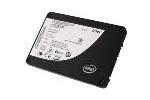|
Intel X25-E 32GB SLC SSD Tested
|
 While still very quick even with the write speeds halved, this certainly takes a lot away from the X25-E, especially in regards to the possibility of using it as a boot partition. While the first run through writing to the disk would be very quick indeed, reusing hard drive space nullifies the huge write speed performance advantage, making the X25-E somewhat of a disappointment, especially considering its 505 GBP price tag. The capacity itself is also a real sticking point - these days 32GB is nothing in terms of storage, and was barely enough space to install Windows Vista Home Premium 64-bit and Crysis. While we love the idea of a fast writing, fast reading drive for use as a boot drive, it needs to actually be able to fit more than the operating system onto it to make it a realistic option. In comparison, the MLC based Intel X25-M doesn't suffer from the same re-write speed problems thanks to MLC using storing data using multiple states per cell, is more than twice the size at 80GB, costs 50 GBP less, and has near identical read performance. If you're in the market for a high end SSD we'd certainly still point you in the direction of the X25-M rather than the X25-E, although for the majority of you, a high speed 1TB drive will likely meet all your storage needs and will also be much more wallet friendly - the excellent Samsung Spinpoint F1 1TB can be had for as little as 73 GBP. Although we love the idea of a fast writing, fast reading, all round speedy hard drive, the X25-E isn't quite there yet. While write speed post-format is impressive, re-write speeds are doubled and read speed is no better than the cheaper, larger mainstream version of the drive. While we're sure fast writing SSDs like the X25-E will find a place in highly specialised business setups, there's just no way such a small and ludicrously expensive drive should find a space in your home system, even if your budget can stretch to it.
While still very quick even with the write speeds halved, this certainly takes a lot away from the X25-E, especially in regards to the possibility of using it as a boot partition. While the first run through writing to the disk would be very quick indeed, reusing hard drive space nullifies the huge write speed performance advantage, making the X25-E somewhat of a disappointment, especially considering its 505 GBP price tag. The capacity itself is also a real sticking point - these days 32GB is nothing in terms of storage, and was barely enough space to install Windows Vista Home Premium 64-bit and Crysis. While we love the idea of a fast writing, fast reading drive for use as a boot drive, it needs to actually be able to fit more than the operating system onto it to make it a realistic option. In comparison, the MLC based Intel X25-M doesn't suffer from the same re-write speed problems thanks to MLC using storing data using multiple states per cell, is more than twice the size at 80GB, costs 50 GBP less, and has near identical read performance. If you're in the market for a high end SSD we'd certainly still point you in the direction of the X25-M rather than the X25-E, although for the majority of you, a high speed 1TB drive will likely meet all your storage needs and will also be much more wallet friendly - the excellent Samsung Spinpoint F1 1TB can be had for as little as 73 GBP. Although we love the idea of a fast writing, fast reading, all round speedy hard drive, the X25-E isn't quite there yet. While write speed post-format is impressive, re-write speeds are doubled and read speed is no better than the cheaper, larger mainstream version of the drive. While we're sure fast writing SSDs like the X25-E will find a place in highly specialised business setups, there's just no way such a small and ludicrously expensive drive should find a space in your home system, even if your budget can stretch to it.
|
|
Quelle: bit-tech.net (E)
|



 While still very quick even with the write speeds halved, this certainly takes a lot away from the X25-E, especially in regards to the possibility of using it as a boot partition. While the first run through writing to the disk would be very quick indeed, reusing hard drive space nullifies the huge write speed performance advantage, making the X25-E somewhat of a disappointment, especially considering its 505 GBP price tag. The capacity itself is also a real sticking point - these days 32GB is nothing in terms of storage, and was barely enough space to install Windows Vista Home Premium 64-bit and Crysis. While we love the idea of a fast writing, fast reading drive for use as a boot drive, it needs to actually be able to fit more than the operating system onto it to make it a realistic option. In comparison, the MLC based Intel X25-M doesn't suffer from the same re-write speed problems thanks to MLC using storing data using multiple states per cell, is more than twice the size at 80GB, costs 50 GBP less, and has near identical read performance. If you're in the market for a high end SSD we'd certainly still point you in the direction of the X25-M rather than the X25-E, although for the majority of you, a high speed 1TB drive will likely meet all your storage needs and will also be much more wallet friendly - the excellent Samsung Spinpoint F1 1TB can be had for as little as 73 GBP. Although we love the idea of a fast writing, fast reading, all round speedy hard drive, the X25-E isn't quite there yet. While write speed post-format is impressive, re-write speeds are doubled and read speed is no better than the cheaper, larger mainstream version of the drive. While we're sure fast writing SSDs like the X25-E will find a place in highly specialised business setups, there's just no way such a small and ludicrously expensive drive should find a space in your home system, even if your budget can stretch to it.
While still very quick even with the write speeds halved, this certainly takes a lot away from the X25-E, especially in regards to the possibility of using it as a boot partition. While the first run through writing to the disk would be very quick indeed, reusing hard drive space nullifies the huge write speed performance advantage, making the X25-E somewhat of a disappointment, especially considering its 505 GBP price tag. The capacity itself is also a real sticking point - these days 32GB is nothing in terms of storage, and was barely enough space to install Windows Vista Home Premium 64-bit and Crysis. While we love the idea of a fast writing, fast reading drive for use as a boot drive, it needs to actually be able to fit more than the operating system onto it to make it a realistic option. In comparison, the MLC based Intel X25-M doesn't suffer from the same re-write speed problems thanks to MLC using storing data using multiple states per cell, is more than twice the size at 80GB, costs 50 GBP less, and has near identical read performance. If you're in the market for a high end SSD we'd certainly still point you in the direction of the X25-M rather than the X25-E, although for the majority of you, a high speed 1TB drive will likely meet all your storage needs and will also be much more wallet friendly - the excellent Samsung Spinpoint F1 1TB can be had for as little as 73 GBP. Although we love the idea of a fast writing, fast reading, all round speedy hard drive, the X25-E isn't quite there yet. While write speed post-format is impressive, re-write speeds are doubled and read speed is no better than the cheaper, larger mainstream version of the drive. While we're sure fast writing SSDs like the X25-E will find a place in highly specialised business setups, there's just no way such a small and ludicrously expensive drive should find a space in your home system, even if your budget can stretch to it.